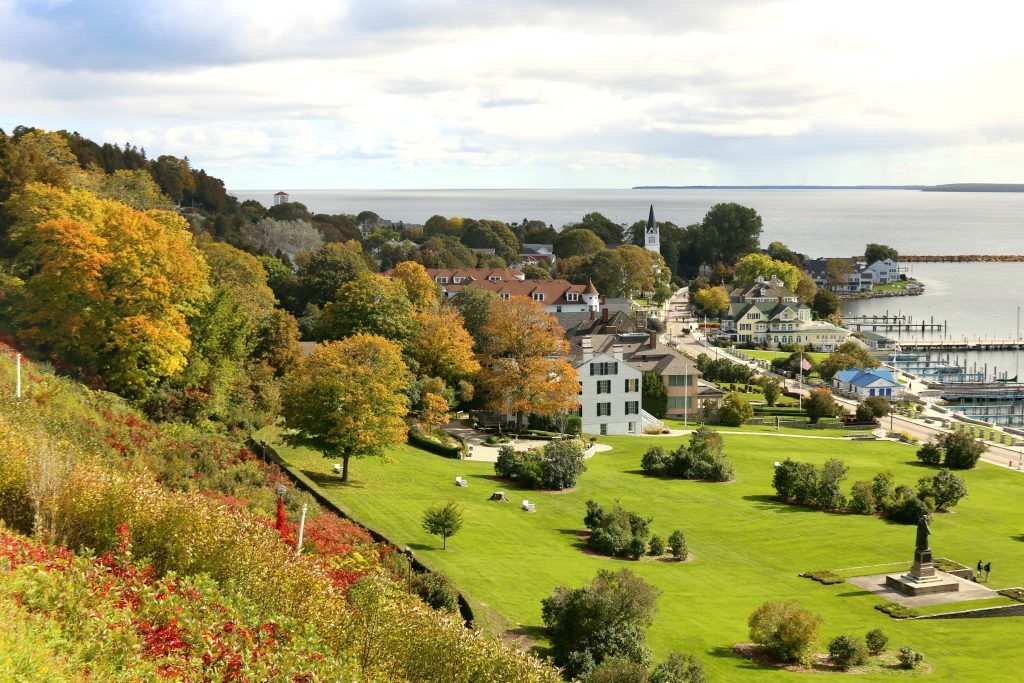There’s a statue on Mackinac Island, right in the middle of everything where you can’t miss it. If you’re into Mackinac Island history, then you’ll appreciate the tale behind the statue. If learning about dead men isn’t your thing, just know that when you find the statue then you’ve found Marquette Park.
Mackinac Island’s Marquette Park is a beautiful greenspace at the foot of historic Fort Mackinac where soldiers in the 1800s tended a garden. These days, what grows in Marquette Park is soft green grass and sweet-smelling lilacs.
Here are a few more things to know about Marquette Park:
Things to Know About Mackinac Island’s Marquette Park
- Marquette Park is where you can find Mile Marker 0 to begin an 8.2-mile bicycle ride around the outer rim of Mackinac Island on M-185, the only state highway in the country that’s car free.
- Marquette Park is where there’s a reproduction of an ancient birchbark chapel that signifies the first European presence on Mackinac Island.
- Marquette Park is the top picnic spot in all of Michigan, according to Readers’ Digest. It’s a wonderful destination overlooking the Mackinac Island harbor where you can enjoy a peaceful lunch after picking up some food at Doud’s Market, the oldest grocery store in the country. Or, as Readers’ Digest suggests for your visit to Marquette Park, “as you watch the ferries go by and escape the hustle and bustle of city life, savor some of the island’s sweet specialty: rich chocolatey fudge. Pure bliss.”
- There’s a playground in Marquette Park, over by the Richard & Jane Manoogian Mackinac Art Museum that’s housed in the historic Indian Dormitory building on the east side of the park.
Marquette Park’s Place in the History of Mackinac Island
In addition to being the perfect picnic spot or meeting place, Marquette Park also provides an interesting look back into Mackinac Island history. If you haven’t already guessed, the statue represents a man named Marquette. Father Jacques Marquette was a French priest who established Catholic missions in the Upper Great Lakes during the late 1600s and discovered the northern reaches of the Mississippi River.
It was 350 years ago in 1670 that Marquette brought a Catholic mission to Mackinac Island along with fellow priest Claude Dablon. That mission is commemorated by the birchbark chapel that you can visit in Mackinac Island’s Marquette Park still today.
The statue of Marquette was installed on Mackinac Island in 1909 and is similar to a statue 160 miles away in Marquette, Mich. and to another in the U.S. Capitol building in Washington, D.C. The Marquette statue looks out over the bay which includes a Mackinac Island marina and docks for ferry boats to bring visitors from the mainland.
Interestingly, the water eyed by the Marquette statue is called Haldimand Bay, named after the 18th century British general who was governor of Quebec – which at the time included what is now Michigan. Haldimand was in charge when Fort Michilimackinac was moved from the northern tip of the Lower Peninsula to Mackinac Island in 1780.
The statue of Marquette overlooking Haldimand Bay brings together in one glance the French, British and Native American histories that all converged on Mackinac Island to make it a truly extraordinary place.
RELATED MACKINAC ISLAND BLOGS:





